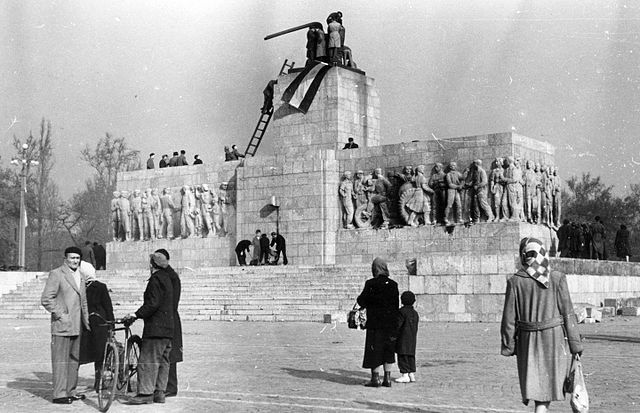Hungarian Revolution of 1956
The Hungarian Revolution of 1956, also known as the Hungarian Uprising, was an attempted countrywide revolution against the government of the Hungarian People's Republic (1949–1989) and the policies caused by the government's subordination to the Soviet Union (USSR). The uprising lasted 12 days before being crushed by Soviet tanks and troops on 4 November 1956. Thousands were killed and wounded and nearly a quarter of a million Hungarians fled the country.
The Hungarian flag (1949–1956) with the communist coat of arms cut out was a revolutionary symbol
Stalin's man in Hungary: Mátyás Rákosi addresses an audience in Budapest, 1948.
In the Eastern bloc, Hungarian Prime Minister Imre Nagy (centre) proved too progressive a Communist in his government's pursuit of the Hungarian road to Socialism, taking it too far out of the Soviet Union's orbit. (October 1956).
In Budapest, anti-communists and nationalists place a Hungarian national flag atop a demolished statue of Josef Stalin.
Hungarian People's Republic
The Hungarian People's Republic was a one-party socialist state from 20 August 1949 to 23 October 1989. It was governed by the Hungarian Socialist Workers' Party, which was under the influence of the Soviet Union. Pursuant to the 1944 Moscow Conference, Winston Churchill and Joseph Stalin had agreed that after the war Hungary was to be included in the Soviet sphere of influence. The HPR remained in existence until 1989, when opposition forces brought the end of communism in Hungary.
Monument in Budapest, dedicated to the leaders of the short-lived Hungarian Soviet Republic of 1919, Tibor Szamuely, Béla Kun, Jenő Landler





